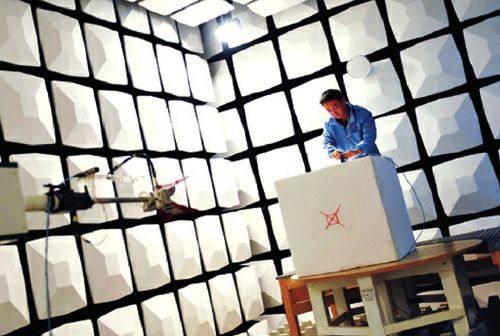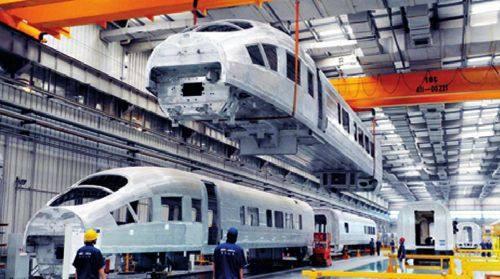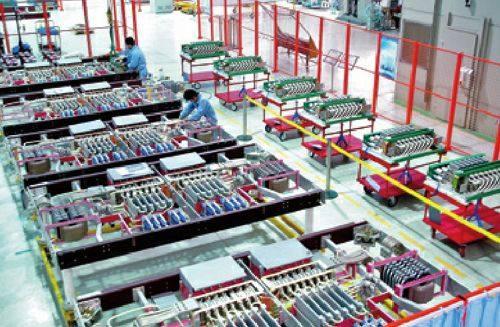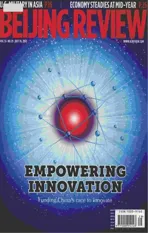GROWTH THROUGH INNOVATION
2012-04-29ByTangYuankai
By Tang Yuankai



Situated in Shenzhen, Guangdong Province, the Shenzhen Institute of Advanced Integration Technology aspires to spearhead science and technology innovation and the application of new technologies.
On July 7, it launched a project to apply cloud computing technology to the machine tool industry, the first of its kind in the country. The technology, jointly developed by the institute and ACL Machinery Group in China, was adopted by U.S. National Aeronautics and Space Administration (NASA), General Motors and Chinese company Huawei Technologies Co. Ltd.
Founded in 2006 under the Chinese Academy of Sciences, it is the only state-owned research institute in Shenzhen. Currently, the institute employs more than 1,600 researchers. So far, it has successfully spawned 60 companies in new technologies such as cloud computing, the Internet of Things, alternative energies and new materials.
“Since its inception, the institute has been committed to institutional innovation, conducting basic and applied research, and commercializing more research results,” said Pan Jianping, a researcher and president of the institute.
Pan said that to convert science and technology into productivity, they must closely wed science and technology with production.
The institute is deemed as a successful example in commercializing science and technology.
Policy-directed innovation
One day before the institute launched its cloud computing technology application project, a national science and technology innovation conference was convened in Beijing. The two-day meeting saw the passage of the Opinions on Deepening Chinas Scientific and Technological System Reform, Accelerating the Building of National Innovation System, with guidelines for a new round of reform.
A conference on scientific and technological innovation at such a high level and of such a grand scale is unprecedented.
While attending the conference, President Hu Jintao urged China to enhance scientific and technological innovation capacity, and to integrate science and technology with social and economic development.
The president proposed suggestions for accelerating the construction of an innovative country, such as promoting innovation-driven development, improving indigenous innova- tion capacity and a system for cultivating talented people, deepening reform of scientific and technological systems, optimizing the environment for innovation, and expanding international cooperation.
Innovation became a buzzword in China several years ago. In June 2004, at a Central Economic Work Conference, President Hu said that scientific and technological innovation capacity is a decisive factor for a countrys development, and the core of a countrys competitiveness. In the last week of that year, he mentioned the word “indigenous innovation” on three occasions related to science and technology.
At the end of 2005, China published the Guidelines on National Medium- and LongTerm Programs for Science and Technology Development (2006-20). The meticulously drafted document said that the goal of deepening scientific and technological system reform is to push forward and improve the construction of a national innovation system.
At the beginning of 2006, at the National Science and Technology Conference, the Central Committee of the Communist Party of China and the State Council published the decision on implementing the guidelines and enhancing the countrys indigenous innovation capacity.
After GDP growth soared near 10 percent for 30 years, foreign media hailed the countrys move to focus more on the composition and quality of GDP in addition to its growth rate.
To implement the guidelines, the government has enacted many detailed implementation rules and promulgated relevant policies. They cover a wide range of areas related to science and technology and innovation such as taxation, financing, education, and innovation platforms.
After innovation was declared a national strategy, it quickly became a social consensus and engine for growth.
Official statistics show that government expenditure on science and technology has grown continuously, maintaining an average annual growth rate of 25.2 percent from 2006 to 2010, and reaching 861 billion yuan ($135 billion), or 1.83 percent of the GDP, last year. Statistics from the Organization for Economic Cooperation and Development indicated that Chinas research and development expen- diture is second only to that of the United States.
Xu Heping, Director of the Research Department of the Ministry of Science and Technology, projected that after adjusting for purchasing power parity, Chinas research and development spending will be more or less equal to that of the United States in 2015.
In 2011, China granted 172,000 patents of invention, up 27.4 percent from the previous year, ranking third in the world, according to the Ministry of Science and Technology. The nation also ranked second in terms of the number of published papers, and seventh in terms of the number of science and technology papers cited, as shown by the Science Citation Index.
According to Beijing-based Science and Technology Daily, China ranks second in theworld in terms of value added in the hi-tech industry, the first in the export volume of hitech products, and second in application for patent of invention.
Enterprise-driven innovation
At the recent national science and technology innovation conference, Premier Wen Jiabao said that the most important task of reforming the science and technology system is integrating science and technology with economy, as well as strengthening enterprises innovation capacity, which is of strategic importance to the long-term development of the country.
Now the most pressing issue for China is to set up an innovative industry research and development system mainly driven by enterprises, said Wan Gang, Minister of Science and Technology.
In his eyes, only by strengthening enterprises role in scientific and technological innovation can the overall effectiveness of the innovation system be enhanced.
That enterprises are the mainstay of technological innovation is a widely accepted idea in many countries, yet in China, the concept is far from being well-established, said Liu Li, a reporter from Science and Technology Daily, who covered the national science and technology innovation conference held on July 6.
“China had been under a planned economy for decades. The governments industrial management departments took on many responsibilities that it should not shoulder, reducing enterprises to virtually processing workshops. So, over time, enterprises have lost the momentum and ability to innovate,” Liu said.
Even today some people still think research institutes should play a major role in innovation. Wan said that on one hand, these people worry that Chinese firms are still too weak in innovative ability to play a key role; on the other hand, they do not have thorough understanding of the basic laws of technological innovation.
In fact, the National Medium- and LongTerm Program for Science and Technology Development (2006-20), published in 2005, called for the construction of an enterprisecentered technological innovation system that combines joint efforts of enterprises, universities and research institutes.
In April 2006, the State-Owned Assets Supervision and Administration Council made technological innovative capacity and research and development spending key criteria in evaluating the performance of executives of state-owned enterprises.
In a market economy, enterprises best understand market needs, said Wan, speaking from his own experience in working at Audi Germany.
“Enterprises can become big and strong only by adapting to market changes, while firms own development requirements are the source of technological innovation,” Wan said.
Many firms have realized the importance of innovation during competition. Recently, Wan visited Gree Electric Appliances, Inc. in Zhuhai, Guangdong Province, whose air conditioner sales have led the world for six consecutive years.
Wan said an air conditioner at his home was produced by the company. “After many years of use, nothing has gone wrong with it,”he said.
In Grees technology research institute, there is a special laboratory in which various weather conditions can be simulated for air conditioners to be exposed to, such as thunderstorms.
This year, Gree won the National Science and Technology Progress Award for researching and commercializing the one-hertz variable frequency air conditioner. Gree is the first air conditioner manufacturer to win this honor, thanks to its growing scientific and technological spending. Last year, its research and development spending was 3 billion yuan($476 million), the highest in Chinas household electric appliance industry.
“We never cap our research and development spending, and the secret of our success is core technology,” said Dong Mingzhu, CEO of Gree.
“Without scientific and technological innovation, a company can only perish,” she added. The saleswoman-turned-businessleader was ranked seventh among this years top 50 women in world business rated by U.K.-based Financial Times.
A growing number of Chinese entrepreneurs are generously investing in research and development. Last year, 74 percent of such investments were made by enterprises, according to data from the Ministry of Science and Technology.
Meanwhile, the allocation structure of government funds has also changed significantly. More and more key national projects in science and technology have been granted to enterprises.
The financial market also plays an increasing role in supporting research and development. The recent high-level conference on innovation also stressed the integration between science and technology and the financial market.
Currently, 52 percent of the 212 Beijingbased A-share listed companies are in the field of science and technology.
In addition, some local governments of Jiangsu, Shanghai and Guangdong have given tax incentives and other preferential treatment to encourage companies to invest in research and development.
In Shenzhen, enterprises begin to play a dominant role in research and development. Data from the Ministry of Science and Technology shows 90 percent of research and development expenditure was paid by enterprises, and 90 percent of the patents were granted to flagship enterprises in 2009.
Despite the progress, scientific and technological reform should be further deepened, as the 2011 National Innovation Index released by the Chinese Academy of Science and Technology for Development showed that the indigenous innovative capacity and core technology ownership of Chinese firms were still not high.
System reform
The current round of reform will focus on improving indigenous innovative capacity, promoting integration of science and technology with economic and social development, and addressing salient issues impeding scientific and technological innovation, said Wan.
The major hurdles to innovation are weak original innovative capacity and a low self-sufficiency rate in key technologies. Enterprises have not been established as the key innovators, the relations between universities, research institutes and enterprises have not been straightened out, while these actors of innovation should be more closely combined so as to improve their overall effectiveness, he said.
The allocation of scientific and technological resources is still too administrationdriven, dispersed and repetitive, which has restrained Chinas innovative capability. To motivate scientists and engineers to engage in innovation, the government should reform the current science management and talent evaluation systems, adopt better measures to cultivate young talent and attract the best and the brightest, to foster a sound environment for innovation, Wan said.
Currently, a prominent issue in integrating science and technology with the economy is a low commercialization rate of research results.
Official statistics show that every year, nearly 6,000 new techniques in agricultural sectors were approved by provincial and ministerial-level governments, yet during the period from 2006 to 2010, only about 40 percent of these achievements were put into commercial use.
Pan Jiluan, a professor with the Department of Mechanical Engineering in Tsinghua University and academician of the Chinese Academy of Sciences, blamed the situation on the inadequate performance evaluation system in research institutes and universities, where researchers tend to be judged by the number of projects they have worked on and the papers they have published, rather than by how many practical problems they have solved or how much economic value they have created.
Li Xiaolin, a professor with China Agricultural University, said that many of his colleagues are engrossed in writing papers and applying for patents, because papers and patents will help them to win academic titles and research funding, whereas they rarely seriously think about what farmers really need, and how to bring their research result to the field.
“Research results should be converted into productivity,” Wan said. He said that research institutes and universities should increase their capability to serve economic and social development.
Foreign R&D Centers in China
l Innovation-friendly environment in China will not only benefit indigenous companies, but also attract foreign firms to engage in research and development in China. Official statistics show that in 1999, multinational corporations had no more than 30 research and development centers in China, whereas currently, more than 3,000 foreign companies have set up research and development centers in the country.
l On May 25, Microsofts Asia-Pacific Research and Development Group Headquarters were officially opened in Beijing, symbolizing the companys focus on China as a key growth market and location for future innovation. Steve Ballmer, CEO of Microsoft Corp. commented: “When Microsoft first opened in Zhongguancun in Beijing 20 years ago, it set into action a vision of growth and innovation that we shared with the Chinese Government and emerging local industry. That vision has come full circle with Microsofts AsiaPacific Research and Development Group Headquarters—which now lays a vital platform for Microsofts future and our belief in Chinas ambitions to transform to an innovation-driven economy.”
(Sources: Science and Technology Daily and Website of Microsoft Asia-Pacific Research and Development Group)
